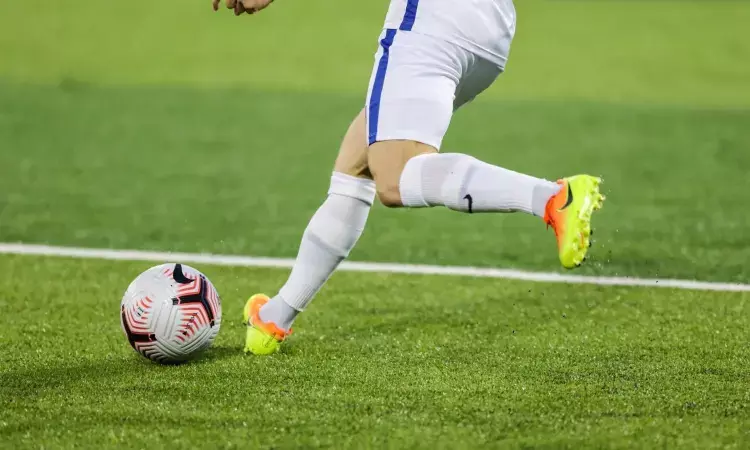- Home
- Medical news & Guidelines
- Anesthesiology
- Cardiology and CTVS
- Critical Care
- Dentistry
- Dermatology
- Diabetes and Endocrinology
- ENT
- Gastroenterology
- Medicine
- Nephrology
- Neurology
- Obstretics-Gynaecology
- Oncology
- Ophthalmology
- Orthopaedics
- Pediatrics-Neonatology
- Psychiatry
- Pulmonology
- Radiology
- Surgery
- Urology
- Laboratory Medicine
- Diet
- Nursing
- Paramedical
- Physiotherapy
- Health news
- Fact Check
- Bone Health Fact Check
- Brain Health Fact Check
- Cancer Related Fact Check
- Child Care Fact Check
- Dental and oral health fact check
- Diabetes and metabolic health fact check
- Diet and Nutrition Fact Check
- Eye and ENT Care Fact Check
- Fitness fact check
- Gut health fact check
- Heart health fact check
- Kidney health fact check
- Medical education fact check
- Men's health fact check
- Respiratory fact check
- Skin and hair care fact check
- Vaccine and Immunization fact check
- Women's health fact check
- AYUSH
- State News
- Andaman and Nicobar Islands
- Andhra Pradesh
- Arunachal Pradesh
- Assam
- Bihar
- Chandigarh
- Chattisgarh
- Dadra and Nagar Haveli
- Daman and Diu
- Delhi
- Goa
- Gujarat
- Haryana
- Himachal Pradesh
- Jammu & Kashmir
- Jharkhand
- Karnataka
- Kerala
- Ladakh
- Lakshadweep
- Madhya Pradesh
- Maharashtra
- Manipur
- Meghalaya
- Mizoram
- Nagaland
- Odisha
- Puducherry
- Punjab
- Rajasthan
- Sikkim
- Tamil Nadu
- Telangana
- Tripura
- Uttar Pradesh
- Uttrakhand
- West Bengal
- Medical Education
- Industry
Higher incidence of accessory ossicles found in foot and ankle among male professional soccer players

Japan: A recent study published in International Orthopaedics reported a higher incidence of accessory ossicles in the foot and ankle in male elite soccer players.
"A higher incidence of the accessory navicular, os subfiblare, os supranaviculare, os trigonum, and os subtibiale was observed among male professional soccer players," the researchers wrote.
Accessory ossicles are caused by the failure of the fusion of secondary ossification centres and occur more likely due to heavy loading during the growth period or improper treatment after injury. Takuya Kinoshita, Osaka Saiseikai Nakatsu Hospital, Osaka, Kita-ku, Japan, and colleagues aimed to investigate the incidence of foot and ankle accessory ossicles in male professional soccer players.
The study included male professional soccer players who underwent medical checkups at the hospital (Osaka Saiseikai Nakatsu Hospital in Japan) between 2017 and 2023 as the soccer group. Medical checkups included radiographs of bilateral anteroposterior and oblique foot and bilateral anteroposterior and lateral ankle. The control group included male patients age-matched with the soccer group who visited the hospital undergoing anteroposterior and oblique foot or anteroposterior and lateral ankle radiography. Accessory ossicle incidence was investigated and compared between the soccer and control groups.
The researchers reported the following findings:
- 276 ankles and 276 feet, as well as 121 ankles and 79 feet, were included in the soccer and control groups, respectively.
- The incidence of accessory ossicles in the soccer and control groups was as follows: accessory navicular 35.9%, 24%, os peroneum 8.0%, 2.5%; os supranaviculare 7.6%, 1.3%; os infranaviculare 1.4%, 1.3%; os calcaneus secundarius 4.3%, 0%; os vesalianum 0%, 0%; os subfiblare 12.7%, 2.5%; os subtibiale 18.1%, 2.5%; and os trigonum 89%, 24%.
"Our findings show that male professional soccer players have a higher incidence of the accessory navicular, os supranaviculare, os subfiblare, os subtibiale, and os trigonum," the research team concluded.
Reference:
Kinoshita, T., Hashimoto, Y., Inui, K. et al. Male elite soccer players have a higher incidence of accessory ossicles in the foot and ankle. International Orthopaedics (SICOT) (2023). https://doi.org/10.1007/s00264-023-06074-4
Dr Kamal Kant Kohli-MBBS, DTCD- a chest specialist with more than 30 years of practice and a flair for writing clinical articles, Dr Kamal Kant Kohli joined Medical Dialogues as a Chief Editor of Medical News. Besides writing articles, as an editor, he proofreads and verifies all the medical content published on Medical Dialogues including those coming from journals, studies,medical conferences,guidelines etc. Email: drkohli@medicaldialogues.in. Contact no. 011-43720751


